Shrimp Lo Mein
This Shrimp Lo Mein is an easy 30-minute meal with juicy shrimp and savory lo mein noodles tossed in the best sauce. You’re going to love this recipe!
Be sure to try my Beef Ramen Noodles and Shrimp Fried Rice recipes next!
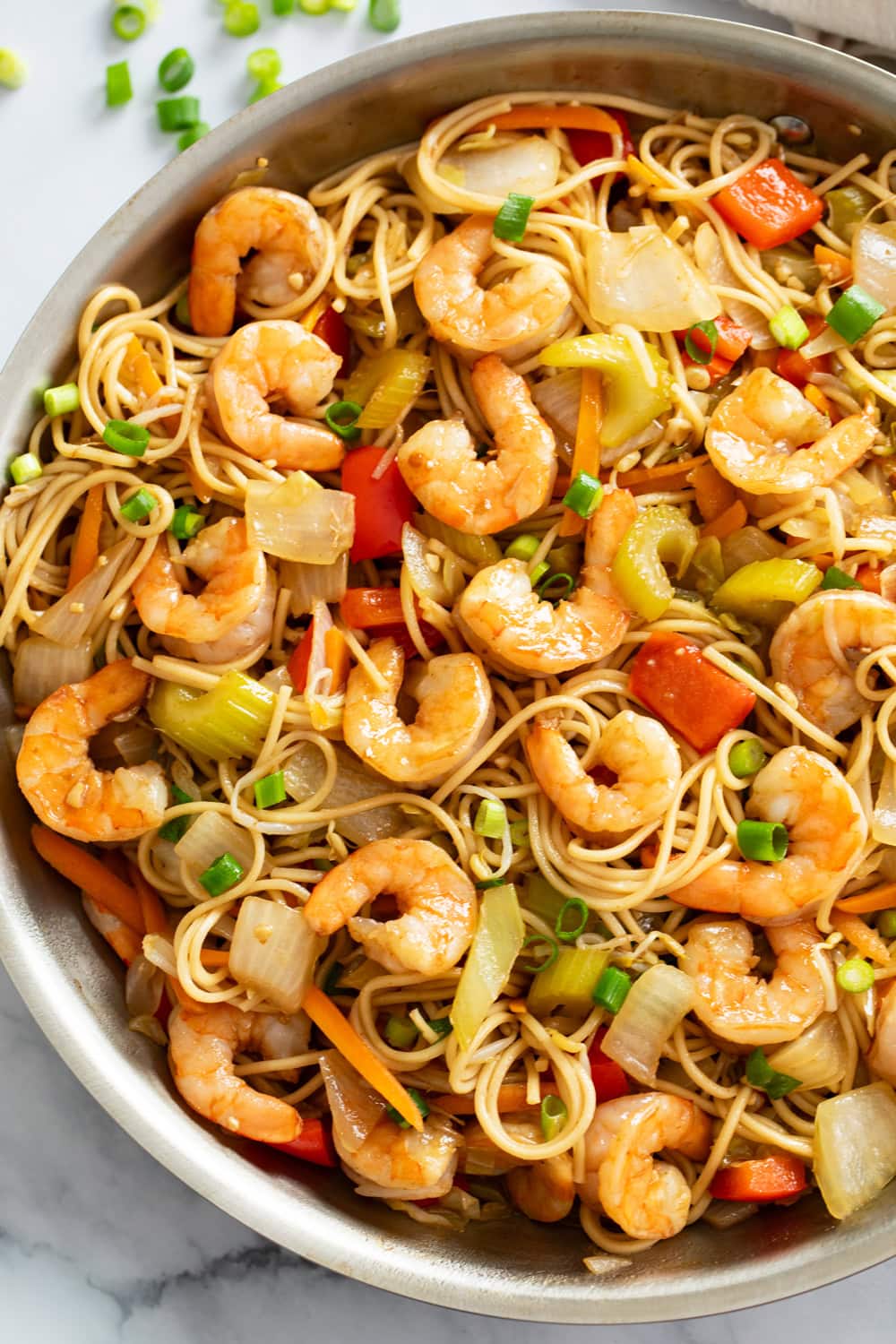
Shrimp Lo Mein
You are going to love the incredible flavors in this Shrimp Lo Mein recipe! The sauce has notes from every flavor element: it’s mostly savory with a hint of heat/sweet, with some earthy umami flavor in the mix, coating those savory noodles, juicy shrimp, and colorful vegetables.
It’s easy to use whatever veggies you have on hand for this as well! Be sure to check out my PRO TIPS below– as well as some tips for cooking with shrimp.
How to Make It
Note: This is an overview. See recipe card below this post for ingredient quantities and full instructions.
Sauté the shrimp in peanut oil and set aside. Pro Tip: Peel the shrimp after sautéing to ensure they don’t cook too quickly! A “c” shape = cooked. An “o” shape = overcooked.
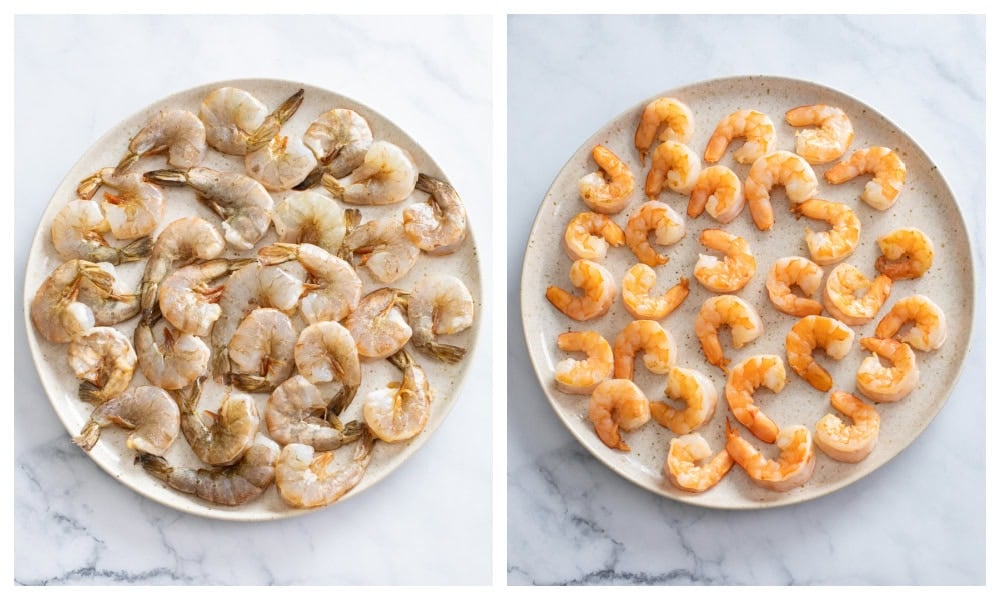
Deglaze the skillet with white wine and reduce by half. Add the onions, peppers, carrots, celery, and cabbage and soften for 4-5 minutes. Add the sauce and bring to a boil to thicken, then reduce to a simmer.
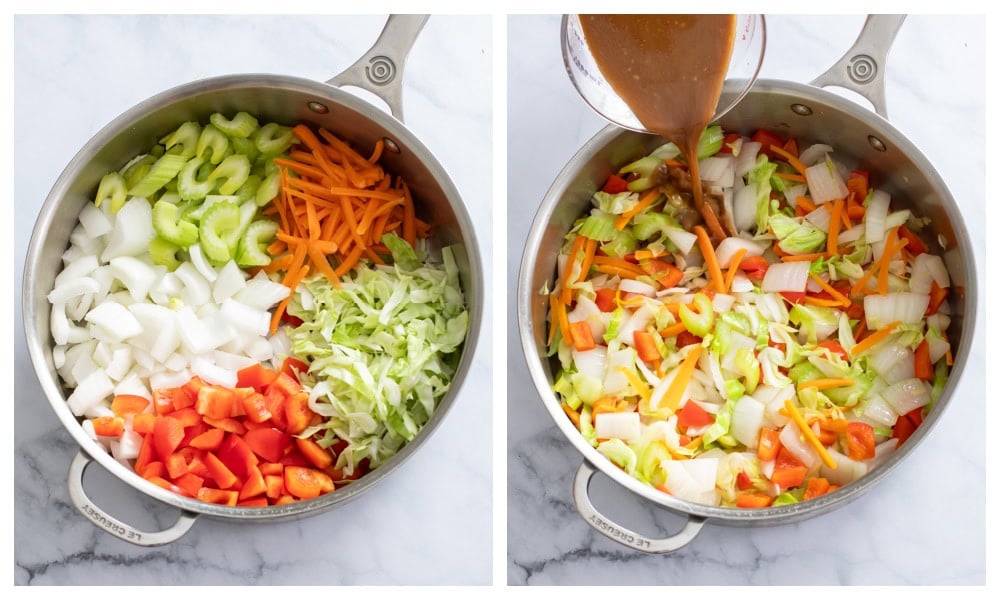
Add the sprouts, followed by cooked lo mein noodles. Add the shrimp back and garnish with green onions. Serve!
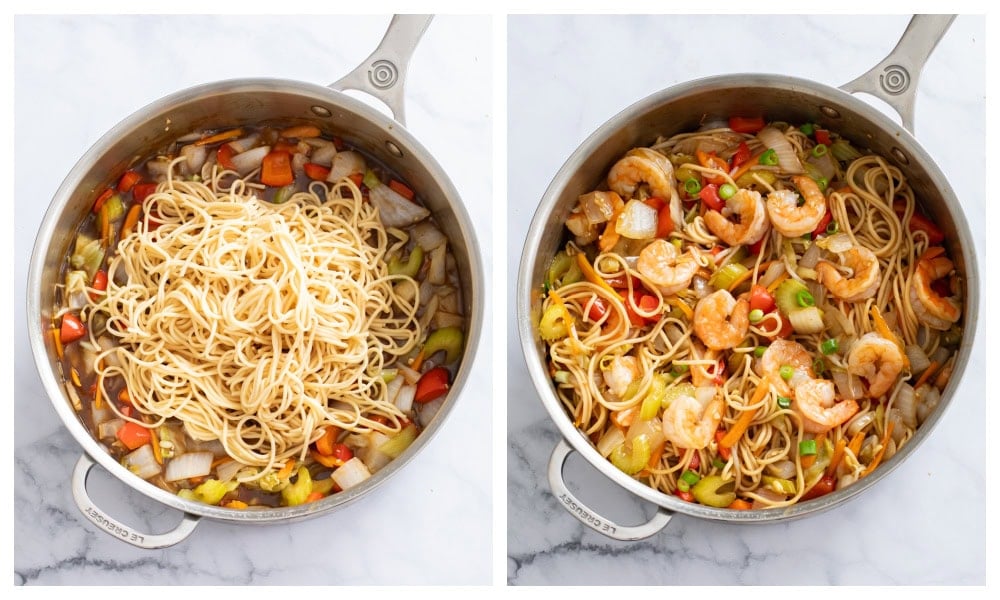
Tips for Cooking With Shrimp
- Size: The size I use is large, and is labeled as 26/30 per pound. (This means that it takes between 26-30 shrimp to equal a pound.) You can use fresh or frozen.
- If using frozen shrimp: Run them under cool water until completely thawed, then pat them dry. You may also need to remove the shells/veins.
- Shrimp can go from cooked to overcooked very quickly, consider setting a timer to avoid overcooking. One way to mitigate this is to peel them after you sauté them, the shell helps protect them from cooking too quickly.
- Shrimp curled into a “c” =cooked. A shrimp curled into an “o” = overcooked.
Pro Tips
- Lo Mein Noodles: These are the kind that I use, they take just 4 minutes to cook. 10 oz. spaghetti noodles can be used instead if needed.
- White Wine: Chardonnay and Pinot Grigio are great wine options to deglaze the pan with after cooking the shrimp. 1/4 cup Shaoxing wine may also be used and will only need to reduce for 2 minutes. An equal amount of chicken broth may be used if you don’t cook with wine.
- Bean Sprouts: I love using fresh bean sprouts for this recipe as they’re crispier and have a fresher taste. Canned may also be used, be sure to drain and rinse them prior to adding. Note that canned bean sprouts also contain sodium.
- Broth: Feel free to use seafood broth/stock in this recipe instead of (or in combination with) chicken broth.
- Sodium: To reduce the sodium in this recipe, consider using low sodium chicken broth and/or soy sauce.
- Cabbage: If you have leftover cabbage after this recipe, use it in these cabbage recipes, including my Egg Roll in a Bowl, Thai Chicken Salad, and Cabbage and Sausage.
- Optional additions to this recipe include: sliced mushrooms, broccoli, snow peas, water chestnuts, green beans, and edamame.
- Other topping options include: honey roasted or regular peanuts, chopped cashews, sliced almonds, chow mein noodles, and Chinese noodles.
Storage
- Store in an airtight container and refrigerate for up to 3 days or freeze for up to 3 months.
- Leftovers do freeze well. Be sure to use a timer when you cook the noodles to ensure they aren’t mushy/overcooked when reheated.
- To reheat: Let it thaw completely and reheat in a skillet on the stovetop over medium heat until just heated through. Overcooked shrimp becomes rubbery, so try to avoid that.
- You can also reheat this in a makeshift double boiler on the stovetop, it applies a nice, even heat without being too direct or harsh.
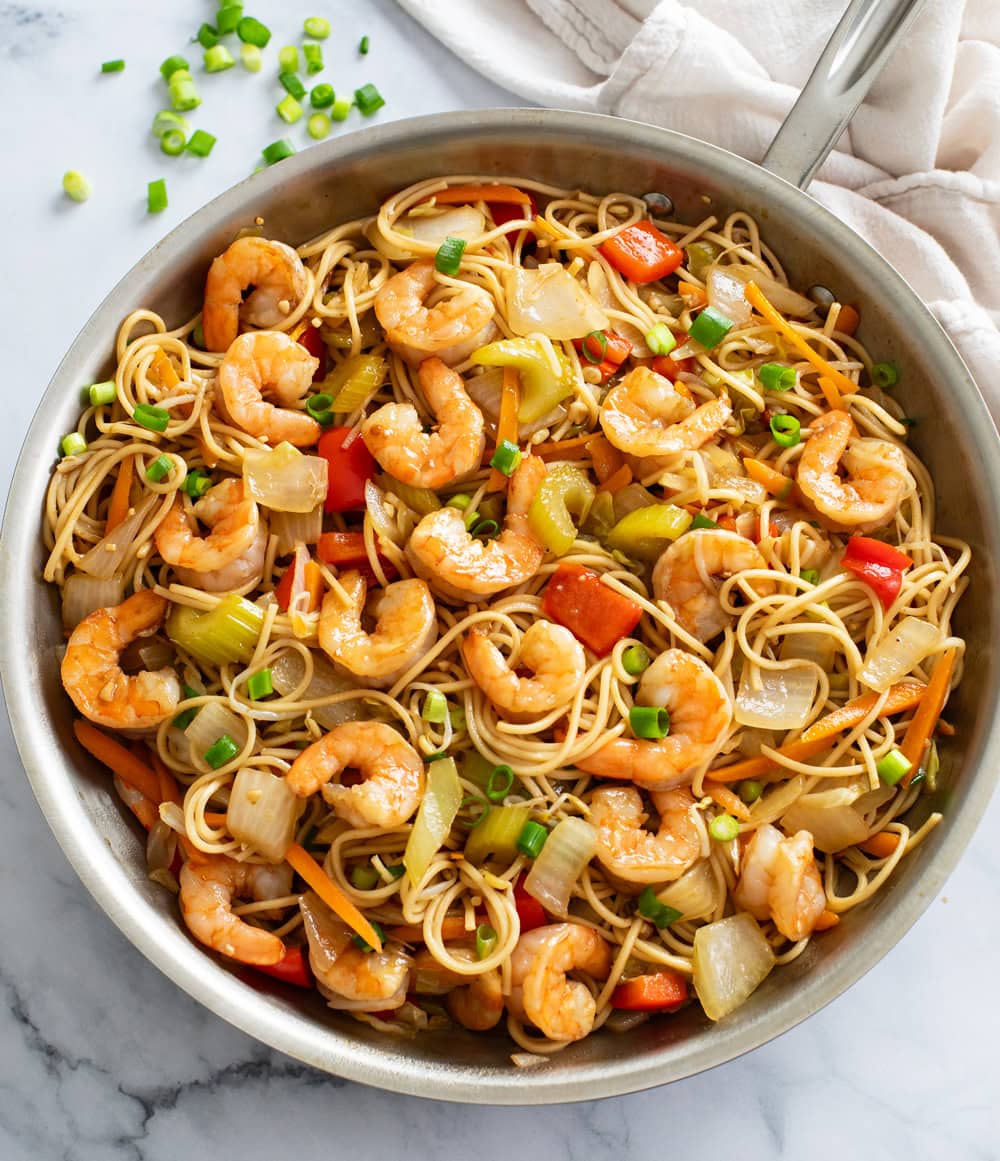
Tools For This Recipe
(Amazon affiliate links*)- Check out all of my kitchen essentials here.
- 3-Quart Stainless Steel Sauté Pan– The same size as pictured in this recipe. A wok is even better!
- 1 quart measuring cup with a spout– This is what I use to combine my sauce ingredients ahead of time.
- My Favorite Chef Knife
- Cutting Boards- I love having assorted sizes. (One for the meat, one for the veggies, etc.)
- Better Than Bouillon– This is what I always use for broth in my recipes. It takes very little space and makes it easy to measure out customized amounts of broth.
- Chopsticks– My favorite way to eat lo mein.
*As an Amazon Associate, I earn from qualifying purchases.
Try These Next
- Shrimp Fried Rice
- Beef Ramen Noodles
- Cajun Shrimp
- Thai Chicken Salad
- Chicken and Orzo
- Chicken Enchiladas
Get My Free E-Book!
- I’ve got a FREE e-Book with 7 super popular dinner recipes! Click here to join my email list and I’ll send your e-Book right over!
- And be sure to follow me on Instagram, Pinterest, & Facebook!
Tried This Recipe?
Leave a review, I love hearing your feedback! ⭐⭐⭐⭐⭐
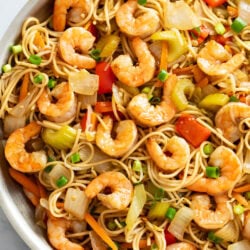
Shrimp Lo Mein
Ingredients
Sauce
- 1 ½ cups chicken broth
- ¼ cup soy sauce
- 1 tablespoon honey
- 1 tablespoon hoisin sauce
- 2 tablespoons cornstarch
- 4 cloves garlic, minced
- 1 teaspoon sriracha sauce, can sub hot sauce
- ¼ teaspoon sesame oil
- ½ tsp ground ginger
- 1 pinch red pepper flakes, optional
Stir Fry
- 1 lb. uncooked shrimp, see notes
- 1-2 tablespoons peanut oil, can sub olive oil
- ½ cup dry white wine, see notes
- 1 small white onion, cut into chunks. Can sub yellow onion.
- 1 red bell pepper, sliced
- ½ cup carrots, julienned
- 2 stalks celery, diced
- 1 cup green cabbage, shredded
- 1 ½ cups bean sprouts, rinsed. See notes
- 6-8 oz. lo mein noodles, see notes
To Garnish
- ¼ cup green onions, sliced
Instructions
- Whisk the sauce ingredients together in a large measuring cup with a spout and set aside. *Ensure the liquid is not warm so that you don't activate the cornstarch.* Measure out remaining ingredients before beginning.
- Thaw the shrimp completely (if frozen) and pat the surface dry. You may also need to remove the shell, tail, and veins. (Pro Tip: I leave the shell on during cooking as it really helps ensure that the shrimp doesn't get overcooked, which is easy to do. Then I let it cool and remove the shell/tail afterwards.)
- Heat oil in a large skillet over medium-high heat. Add the shrimp and cook for about 1 minute + 20 seconds per side. (Use a timer to avoid overcooking). Tilt the pan to transfer the shrimp onto a clean plate. Note that they’ll cook a little bit more as they sit, and again when added back to the sauce.
- Turn the heat off and add the wine. Set the heat to medium and use a silicone spatula to “clean” the bottom and sides of the skillet, this will add flavor to the sauce. Let it bubble and reduce by half, about 4 minutes.
- Boil the noodles for 1 minute less than al dente according to package instructions. (Set a timer to avoid overcooking.) Drain once cooked. (Optional: Drizzle with a little oil and toss to coat.)
- While the noodles cook, increase the heat to medium-high and add the onions, peppers, carrots, celery, and cabbage to the skillet with the wine and cook for about 4-5 minutes to soften slightly.
- Stir the sauce and add it to the skillet. Bring it to a boil to activate the cornstarch and thicken the sauce. Once thickened, reduce heat to low.
- Add the bean sprouts.
- Add the cooked noodles a bit at a time, tossing to coat until desired noodle-to-sauce- ratio is obtained. The noodles will continue to absorb the sauce and the flavors will meld as it stands.
- Add the shrimp back and allow it to heat through, 1-2 minutes. Garnish with green onions and serve!
Notes
- Shrimp: The size I use is large, and is labeled as 26/30 per pound. (This means that it takes between 26-30 shrimp to equal a pound.) You can use fresh or frozen. See blog post for more tips about cooking with shrimp.
- Lo Mein Noodles: These are the kind that I use, they take just 4 minutes to cook. 10 oz. spaghetti noodles can be used instead if needed.
- White Wine: Chardonnay and Pinot Grigio are great wine options to deglaze the pan with after cooking the shrimp. 1/4 cup Shaoxing wine may also be used and will only need to reduce for 2 minutes. An equal amount of chicken broth may be used if you don’t cook with wine.
- Bean Sprouts: I love using fresh bean sprouts for this recipe as they're crispier and have a fresher taste. Canned may also be used, be sure to drain and rinse them prior to adding. Note that canned bean sprouts also contain sodium.
- Broth: Feel free to use seafood broth/stock in this recipe instead of (or in combination with) chicken broth.
- Sodium: To reduce the sodium in this recipe, consider using low sodium chicken broth and/or soy sauce.
- Cabbage: If you have leftover cabbage after this recipe, use it in these cabbage recipes, including my Egg Roll in a Bowl, Thai Chicken Salad, and Cabbage and Sausage.
- Optional additions to this recipe include: sliced mushrooms, broccoli, snow peas, water chestnuts, green beans, and edamame.
- Other topping options include: honey roasted or regular peanuts, chopped cashews, sliced almonds, chow mein noodles, and Chinese noodles.
Storage:
- Store in an airtight container and refrigerate for up to 3 days or freeze for up to 3 months.
- Leftovers do freeze well. Be sure to use a timer when you cook the noodles to ensure they aren't mushy/overcooked when reheated.
- To reheat: Let it thaw completely and reheat in a skillet on the stovetop over medium heat until just heated through. Overcooked shrimp becomes rubbery, so try to avoid that.
- You can also reheat this in a makeshift double boiler on the stovetop, it applies a nice, even heat without being too direct or harsh.
Nutritional information is an estimate and is per serving. There are 4 servings in this recipe.


 Get my Cookbooks!
Get my Cookbooks! 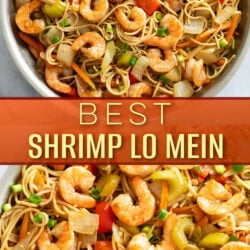
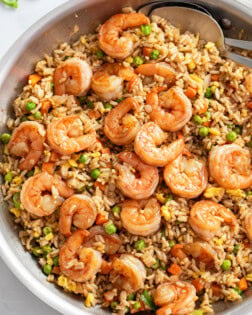
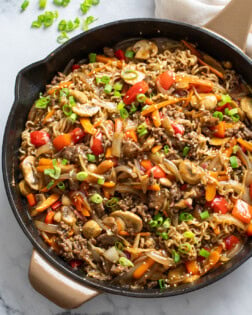
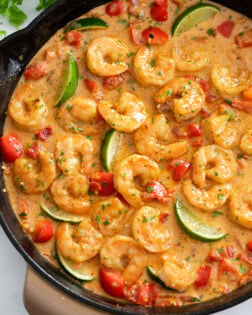
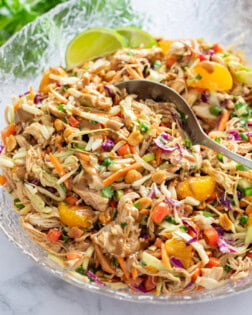
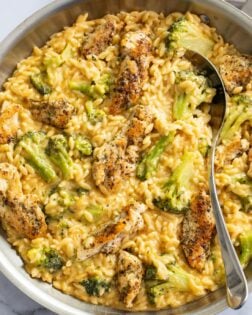
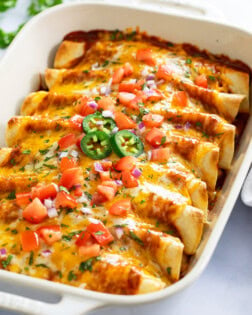

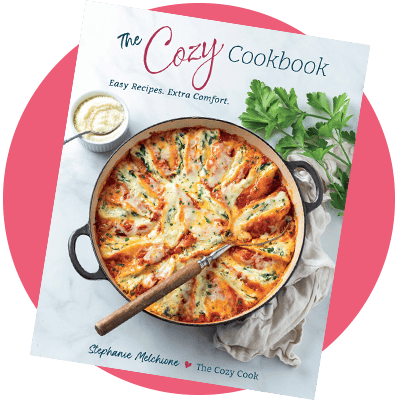
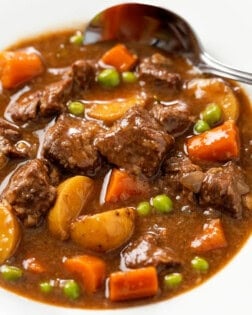
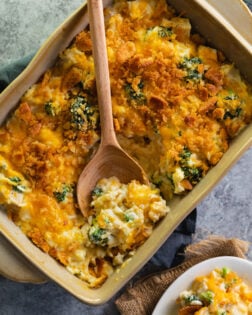
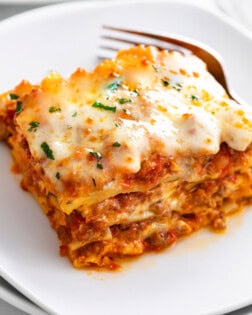
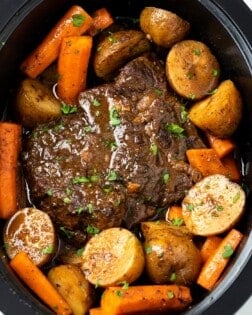

SOOOO easy and SO good! I wish I found this recipe sooner, my husband and I both went back for seconds. Definitely a keeper.
I’m sooo happy to hear that Nina!!!! Awesome! Such a great recipe for this time of year! Thank you so much for the review!!